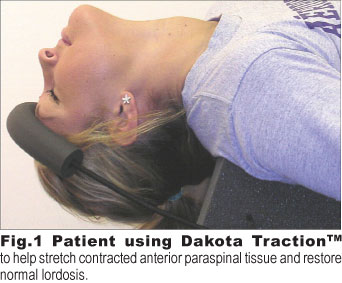Last issue, i documented the ineffectiveness of traditional adjustments to substantially change spinal structure. I would like to explain one key reason why adjustments, typically, produce very little structural change. Once you understand how the laws of physics sabotage your adjustments, you’ll be well on your way to making the best corrections of your career.
The problem with physics is that personal opinions don’t matter. It doesn’t matter what they taught us in school, what our practice manager said, or what we happen to believe. Want to know why your adjustments can’t change spinal structure consistently? The answer is painfully obvious when you consider the basic mechanical characteristics of the spine. Most of us had some exposure to basic physical principles in our pre-chiropractic education. Apparently, someone just forgot to tell us how to actually apply them.

The spine is a bony column within an ocean of soft tissue. Posture may be adversely impacted due to injury/deconditioning of the column, the surrounding tissues, or other structures along the kinetic chain. Once injured, the body may adapt and compensate in numerous ways. Surrounding muscles may weaken or become tight/overactive. Supporting ligaments, tendons, and fascia may be overstretched or chronically shortened. Discs degenerate under abnormal loading. Patients compensate for pain or weakness by developing new, often less efficient, ways to move. The nervous system learns new motor habits. The brain slowly adapts to a new perception of what is normal. As you already know, most of this happens so gradually that the patient often has little or no awareness of how off balance and weakened they have become.
Into this complicated collision of cause and effect, action and reaction, steps the bright eyed, bushy-tailed, and hopelessly optimistic young doctor. Armed with only an adjustment, you wade into battle against the effects of time. Undeterred, you find the most dysfunctional joint(s) and give it your best shot. The adjustment is delivered in a fraction of a second. The timing is perfect. The spine yields. The segment moves. The joint cavitates. It’s all so reassuring. It feels so real. But, it’s what you don’t feel that is more important. Because, by the time your hand leaves the spine, the elastic properties of the surrounding soft tissues rebound the spine right back to its original position.

You probably recall terms like “elasticity,” “viscosity,” and “plasticity” from your high school physics class. Elasticity is pretty self explanatory. It’s the tendency of matter, in this case the paraspinal tissues, to snap back once the force of your adjustment is removed. Think of a rubber band. It responds instantly to stretching forces but the change is only temporary. Viscosity describes the tendency of some thick liquid substances to slowly “flow” and remodel over time. Think of thick motor oil or, if you’re from the South, that last drop of molasses which always seems to find its way out of your biscuit onto your lap. Viscous materials move slowly over time with almost no force required. And, unlike elastic materials, the change is permanent. Finally, plasticity describes the nature of semi-solid substances to also permanently remodel, once the applied force exceeds a certain “yielding point.” A good example of a highly plastic material is a block of modeling clay which yields to the force of the sculptor and then permanently retains the new shape.
As it turns out, all living tissues possess some combination of these three properties. Bone, for example, isn’t particularly elastic. Some ligaments have high elastin content and are, therefore (duh!), very “elastic”. Tissues with higher water content tend to be more viscous, since water is a highly viscous material. Discs have less elastin and water and are, therefore, more plastic in nature. Taken as a whole, the large ligaments, muscles, and tendons surrounding the spine tend to be mostly viscous and elastic (viscoelastic). As we’ve seen, the more elastic components are resistant to permanent change. But, what if we could address the viscous and, to a lesser extent, plastic elements?

As it turns out, the only way to effectively stretch the surrounding tissues is to apply continuous force over time. Time, the very thing we need most, is the one thing our rapid adjustments can’t provide. To stretch the tissues, we’ll need to apply sustained corrective forces continuously for 20-30 minutes daily. That’s going to require a few basic tools, unless you want to manually hold that stretch on every patient. Life’s way too short for that!
Dr. Mark Payne is the president of Matlin Mfg., a manufacturer and distributor of postural rehab products since 1988. To download a full and unabridged version of this article, link to www.MatlinMfg.com. Interested doctors may contact our office for my FREE REPORT, Suggested Screening Procedures for Patient Safety.
If you are interested in learning more on the subject, call our office. I’ll be glad to share how you can improve your corrective care outcomes by 200-300 percent over adjusting alone without changing your technique or spending a fortune. Contact us at 1-334-448-1210 for your Free Report on patient safety.
